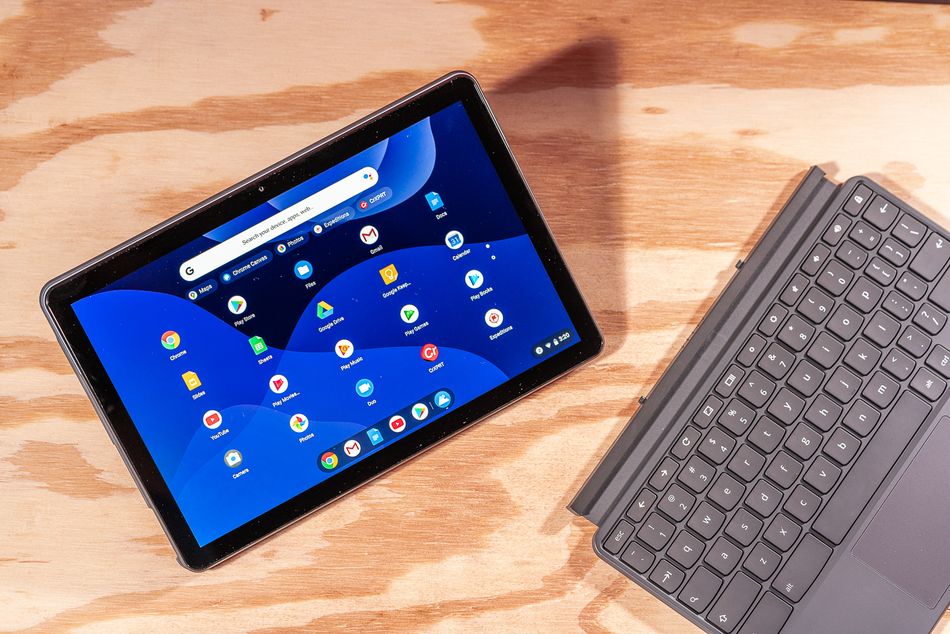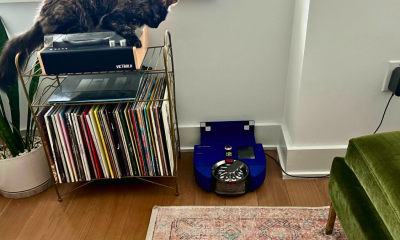Technology
Lenovo Chromebook Duet vs. 10.2-inch iPad: Which hybrid is best?

Whether you’re in the midst of the oddest school year of your life or you’re just getting ready to start, you’re going to need a device for your academic activities. Thankfully, Apple and Lenovo both have some solid options for you.
On the Lenovo side, we’ve got a nifty little hybrid laptop/tablet called the Chromebook Duet. Starting at $279, it comes with both a tablet and a detachable keyboard for any serious work that needs to get done. Staring down the Chromebook Duet is Apple’s latest entry-level iPad, a 10.2-inch tablet with a full suite of Apple apps and services, and a higher price tag ($329 at bare minimum).
Both may be tablets with fully functional keyboard accessories, but their differences outweigh their similarities. If you’re scratching your head because you can’t figure out which tablet is best for you, allow us to help.
Which tablet has the best display?
The Chromebook Duet’s display easily detaches from its keyboard.

Image: zlata ivleva / mashable
Whether your dorm roommates are hogging the TV or you just don’t feel like getting out of bed, it’s reasonable to assume that you’ll eventually use either the Chromebook Duet or the iPad to watch films or TV. After all, why get a tablet if not to take advantage of its bigger screen compared to a phone?
In this regard, the Chromebook Duet and iPad are fairly similar, but one just barely takes the top prize.
Lenovo’s tablet has a marginally smaller display than the iPad at 10.1 inches, with a 1900 x 1200 resolution and 400 nits of brightness to keep things looking relatively sharp and readable. (“Nits,” by the way, is the unit of measurement for brightness. If you didn’t know that before, you learned something new today. Congratulations!)
Those are pretty decent screen specs for a sub-$300 device. Unfortunately for Lenovo, Apple has it beat with the pricier iPad. Its 10.2-inch display is bolstered by a superior 2160 x 1620 resolution and 500 nits of brightness. It’s (slightly) bigger, sharper, and brighter.
Winner: iPad
Which tablet has the better performance?
It’s not always the speediest machine, but the Chromebook Duet can keep up.

Image: zlata ivleva / mashable
The Chromebook Duet is a largely excellent little device, with a battery promising 10 hours of use that should get you through a whole work or school day before it needs to be charged again. Unfortunately, moment-to-moment performance is one area where Lenovo’s enticingly low price rears its head.
As I mentioned in my review, the Duet always feels like it’s hovering at or slightly below the speed limit without ever kicking things into high gear. You can absolutely use it for daily web browsing or school tasks without encountering huge problems, but it never quite feels buttery smooth. Open too many tabs and it’ll probably slow down a bit.
It’s just hard to compete with Apple when it comes to performance. The relatively old A10 Fusion chip inside the basic iPad means it won’t be on par with the newer iPad Pro, but the general smoothness that you get with any modern Apple product puts the iPad over the top in this category.
Winner: iPad
Are the detachable keyboards any good?
Lenovo’s keyboard has a built-in trackpad, but Apple’s does not.

Image: zlata ivleva / mashable
There are plenty of small differences between these two tablets, but Lenovo and Apple have one major breaking point as it pertains to our comparison: The Chromebook Duet is meant to be used as a laptop, while the iPad can be used as one. This difference is key to understanding which one is a better purchase for you.
Specifically, the Chromebook Duet comes packaged with a keyboard that attaches magnetically and includes a trackpad for mouse movement. The keyboard is a little small in order to accommodate the meager size of the tablet itself, so people with larger hands should be prepared to screw up while typing as they get used to it. Aside from that, it does the job admirably.
Apple’s problem here isn’t one of build quality so much as one of availability. The regular iPad doesn’t come with the Smart Keyboard attachment, as Apple charges $159 for the privilege of having a keyboard at all. That keyboard, by the way, doesn’t have a built-in trackpad. Instead of turning the iPad into a laptop, it turns the iPad into a tablet with a keyboard. Still extremely useful for plenty of day-to-day tasks, but Lenovo is just a little more committed when it comes to keyboard support.
Winner: Chromebook Duet
Okay, so tell me: Are there any special features?
Apple Pencil support is a nice bonus of iPad ownership.

The largest software difference between the Chromebook Duet and the 10.2-inch iPad lies in their respective operating systems. Your personal preference here could go a long way to determining which tablet is right for you.
Lenovo’s device runs on Chrome OS, like all Chromebooks. It’s a Google operating system, meaning you’ll use Chrome and Google’s related suite of apps for everything. If you already live a life centered around Gmail, Google Drive, Google Calendar, and Google Meet, you’ll fit right in here. It’s all built-in, and if you log in with your Google account, everything you have in cloud storage will be immediately accessible.
Of course, the iPad runs on iPadOS. It’s like the iOS that fuels your iPhone, except for iPads. You get access to all of Apple’s fancy features, including app multitasking and FaceTime. It’s worth noting that a Chromebook can multitask, too. But on the software level, whether you’re bought into Google’s ecosystem or Apple’s should factor into your decision.
In terms of hardware features, both tablets support styluses like the HP USI stylus for the Duet or the first-gen Apple Pencil for the iPad, but neither comes packed with one in the box.
The biggest advantage Apple has in this category, and the reason it has to win, is SIM support. The iPad can connect to cellular networks if you’re willing to pay at least $459 for it. That’s huge, especially on a campus where WiFi might not always be ideal.
Winner: iPad
So which tablet offers the best value?
Getting all of this costs a lot of money.

We like Apple products around here, but even the most devoted Apple-head has to acknowledge that you pay a premium to get the company’s hardware. In simpler terms, sometimes Apple charges a little bit too much for things. Lenovo, at least in this case, didn’t do that.
The Chromebook Duet comes in two configurations, a 64GB model for $279 and a 128GB model for $299. Otherwise, the two models are the same. It’s a fantastic price point for a tablet that doesn’t pack in a ton of processing power but is more than strong enough to act as a daily portal to the internet and word processors.
We can’t really say the same for the iPad. Its $329 starting price is pretty great for an Apple tablet, but that’s just for the 32GB version with no extra features. If you want 128GB of storage and cellular network coverage, it balloons all the way up to $559, which doesn’t include the cost of getting a keyboard. That’s not exorbitant by tablet standards, but it’s almost twice as much as the most expensive Chromebook Duet configuration.
Lenovo dunks all over Apple when it comes to value.
Winner: Chromebook Duet
The Verdict
The Chromebook Duet and 10.2-inch iPad are different products that serve slightly different audiences. Lenovo’s offering is weaker as a pure tablet, but Chrome OS and a packed-in keyboard and trackpad turn it into a decent little schoolwork machine that you can slip into a small bag. It’s also truly affordable, giving users plenty of versatility without bankrupting them.
Apple’s basic iPad is a worthy contender by most standards, too. The screen is brighter and sharper than the Chromebook Duet, and Apple always makes sure its devices have quick and breezy performance. SIM support is also clutch, especially on a campus, but the price jump might be too much for some students to handle.
Unfortunately for Apple, the iPad’s advantages aren’t enough to offset Lenovo’s wins on value and school day functionality. The Chromebook Duet can get you a lot more storage, and a totally usable keyboard and trackpad for much less money. The iPad might be a better device overall, but for people who need a little laptop that won’t get in the way or ruin their day, the Chromebook Duet is tough to beat.
Winner: Chromebook Duet
-

 Business3 days ago
Business3 days agoAPI startup Noname Security nears $500M deal to sell itself to Akamai
-

 Entertainment3 days ago
Entertainment3 days agoHow to watch ‘Argylle’: When and where is it streaming?
-

 Business6 days ago
Business6 days agoYoshi Mobility has come a long way since gassing up cars on the side of the road
-

 Business4 days ago
Business4 days agoUS think tank Heritage Foundation hit by cyberattack
-

 Entertainment3 days ago
Entertainment3 days agoNASA discovered bacteria that wouldn’t die. Now it’s boosting sunscreen.
-

 Entertainment4 days ago
Entertainment4 days agoCrypto and taxes: Which forms you need to file
-

 Entertainment3 days ago
Entertainment3 days agoDyson 360 Vis Nav robot vacuum review: Dyson should just stick to upright vacuums
-

 Business7 days ago
Business7 days agoSprinto raises $20M to bring automation to security compliance management




















